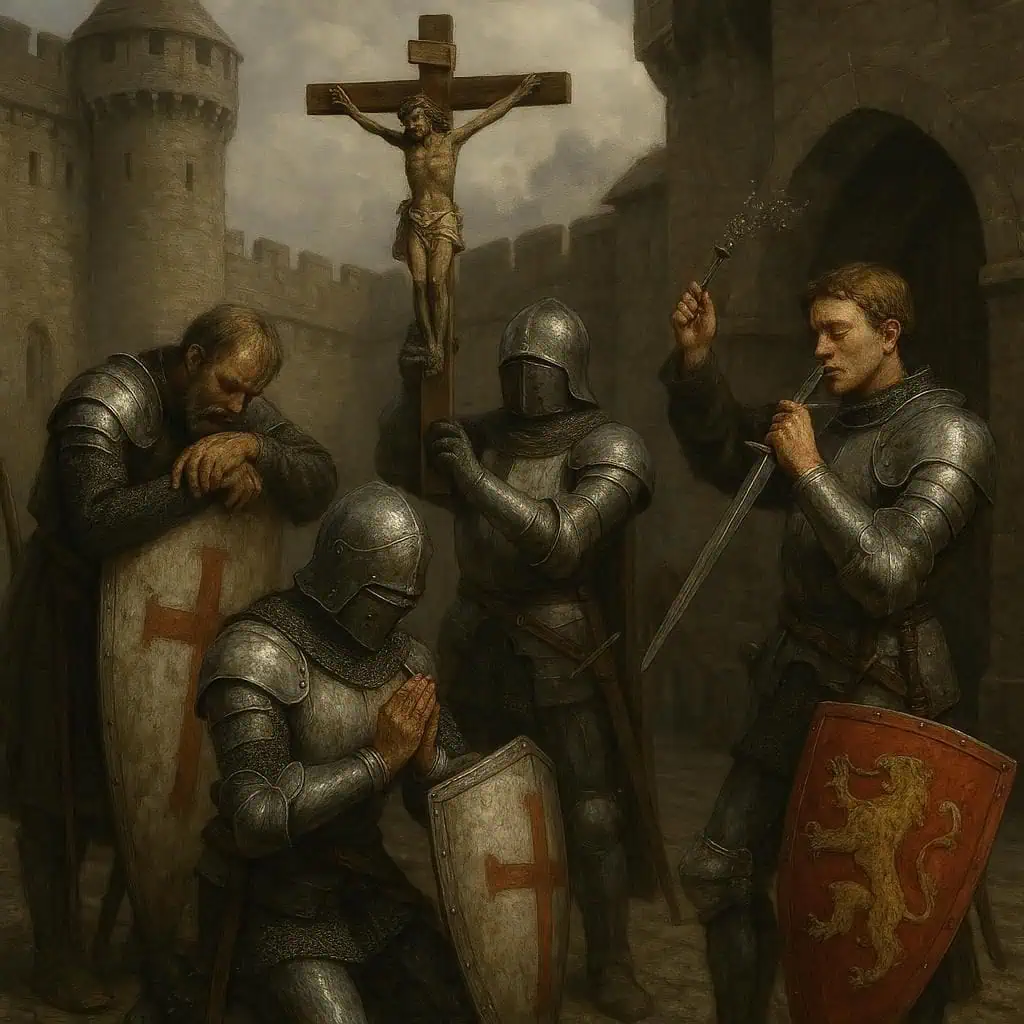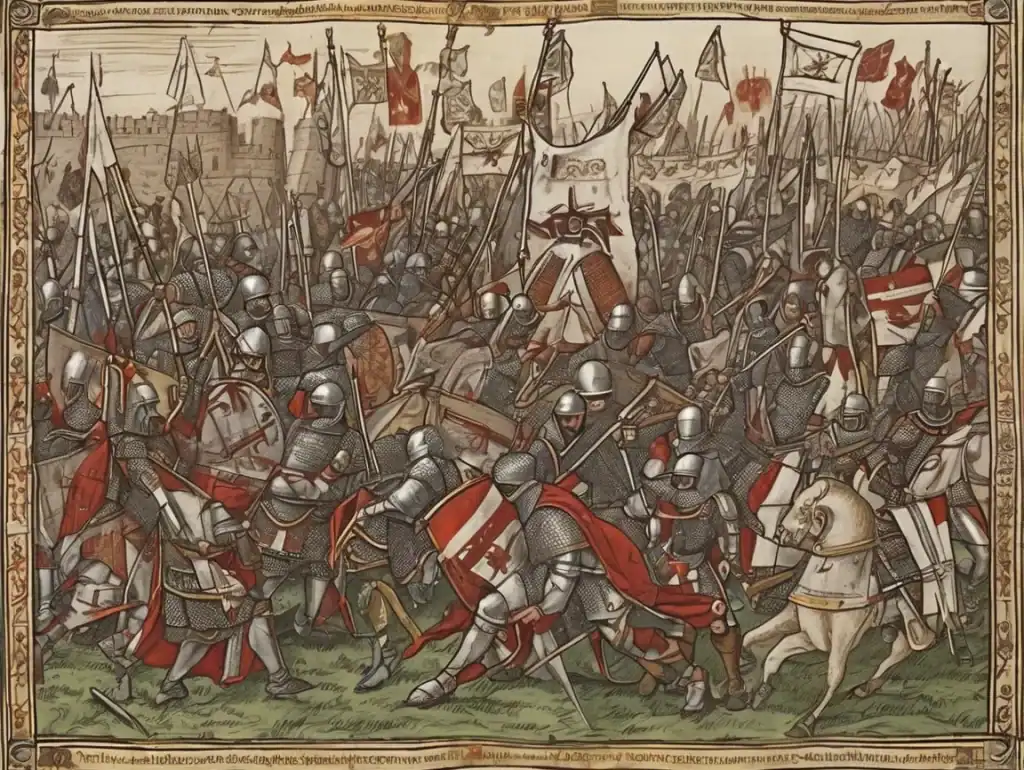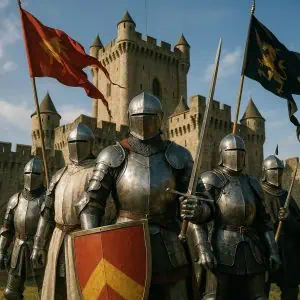When we picture medieval knights, most of us imagine shining armor, galloping horses, and clashing swords. But before any battle or siege, knights often engaged in a series of rituals, prayers, and superstitions designed to protect them from harm and ensure victory. These practices reveal a fascinating mix of religion, superstition, and psychology, showing that medieval warfare was as much about the mind as the sword.

✝️ Morning Prayers and Blessings
Many knights began the day with prayers or blessings, often seeking protection from God, saints, or patron figures. Chaplains or priests would bless their armor and weapons, sometimes marking them with holy symbols or sprinkling them with holy water.
💡 Did you know? Some knights believed that a blessed sword could strike truer and pierce even the toughest armor.
🛡️ Wearing Lucky Charms
Knights often carried amulets, relics, or tokens for protection. These could include:
- Small crosses or medallions from the local church
- Hair or fabric from a loved one
- Pieces of relics believed to contain holy power
These charms were considered to bring courage, luck, and divine favor in the chaos of battle.
📜 Oaths and Vows
Before a campaign, knights frequently swore oaths of loyalty and bravery, not only to their lord but also to God and fellow comrades. Some took additional vows of purity, chastity, or temperance to strengthen their spiritual standing.
💡 Did you know? Breaking a personal or religious oath was thought to bring bad luck or defeat, making the promise as much psychological as moral.
🔮 Superstitious Rituals
Medieval knights were deeply superstitious, often performing peculiar rituals to ensure victory:
- Circling the battlefield or castle walls three times before combat
- Touching the hilt of their sword to the ground for luck
- Avoiding wearing certain colors or symbols deemed unlucky
Some even believed that eating specific foods, like eggs or garlic, could boost courage or ward off evil spirits.
🏇 Pre-Battle Feats and Exercises
Knights didn’t just rely on faith—they also engaged in ritualized training to prepare mentally. This included:
- Practicing mock duels and jousts
- Performing choreographed exercises with armor to get used to its weight
- Testing bows, lances, and crossbows in symbolic ways to honor tradition
These acts reinforced both physical readiness and superstition, giving knights a sense of control over unpredictable outcomes.
🤝 Encouragement from Comrades
Group rituals were common too. Knights would:
- Form a circle of prayer
- Recite battle cries together
- Exchange tokens or personal blessings with fellow soldiers
💡 Did you know? These shared rituals strengthened camaraderie and morale, making knights feel invincible as a unit, even when facing overwhelming odds.
✝️ Patron Saints and Religious Guidance
Many knights had patron saints they prayed to before battle. St. George, St. Michael, and St. Catherine were popular choices. Some knights even carved symbols or names of saints into shields or armor, believing divine favor would follow them onto the battlefield.
😂 Humorous or Odd Beliefs
Not all rituals were serious. Some knights held quirky or amusing superstitions:
- Avoiding battle if they saw a black cat cross the camp
- Refusing to wear armor on a certain day of the week
- Carrying coins or tiny bones for good luck
While these seem strange today, they reflect the human desire to control the uncontrollable in the chaos of medieval warfare.
🌟 Courage, Faith, and the Unseen Edge
The rituals and superstitions of medieval knights reveal a side of warfare rarely discussed in textbooks. Beyond swords and strategy, knights relied on faith, luck, and symbolic acts to prepare mentally for the horrors of battle. Whether through prayers, charms, vows, or humorous rituals, these practices strengthened their resolve, morale, and sense of protection.
In the end, victory in medieval warfare was not just a matter of skill or strength—it was a blend of courage, discipline, and belief in forces both seen and unseen. For every lance raised and every wall defended, knights carried centuries of ritual, superstition, and human ingenuity into the fray.

Were some pre-battle rituals humorous or unusual?
Yes, some knights had quirky superstitions, such as avoiding black cats, carrying tiny bones, or refusing to wear armor on certain days, reflecting human attempts to control fate.
Did rituals include physical preparation as well as spiritual acts?
Yes, knights combined ritualized exercises, mock duels, and weapon testing with prayers and charms to prepare both physically and mentally.
Did knights perform group rituals before battle?
Yes, knights engaged in shared prayers, battle cries, and token exchanges, boosting morale and camaraderie among troops.
Were knights superstitious before going to war?
Absolutely. Knights practiced superstitious rituals, like circling the battlefield, touching the sword hilt to the ground, or avoiding unlucky colors.
What role did patron saints play in knights’ rituals?
Knights often prayed to patron saints such as St. George or St. Michael and sometimes carved saint symbols on shields or armor for protection.
Did knights carry lucky charms or tokens?
Yes, many knights carried amulets, relics, or personal tokens believed to bring courage, luck, and divine protection.
What rituals did medieval knights perform before battle?
Medieval knights performed prayers, blessings, oaths, and symbolic acts to seek protection and favor before battle.






